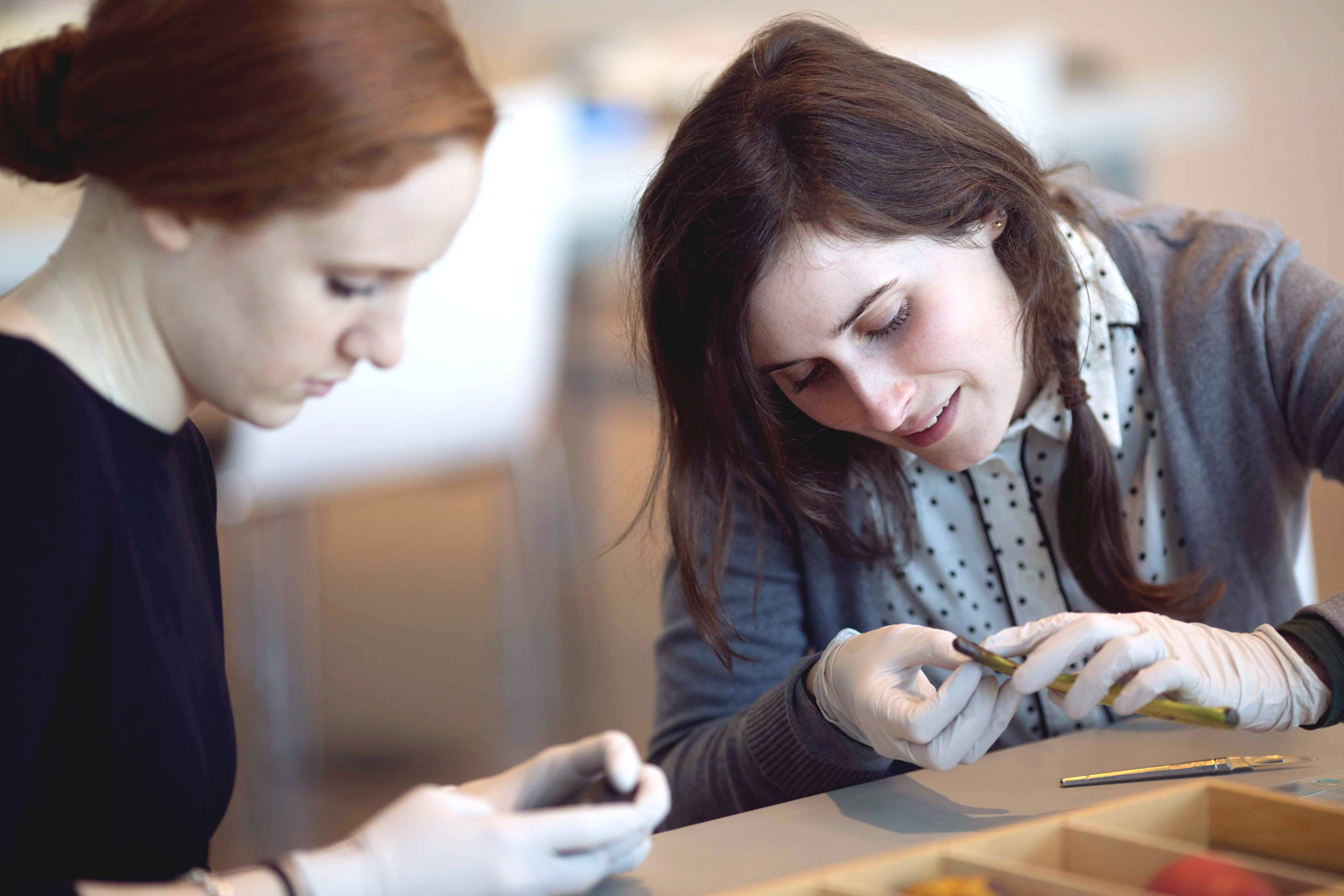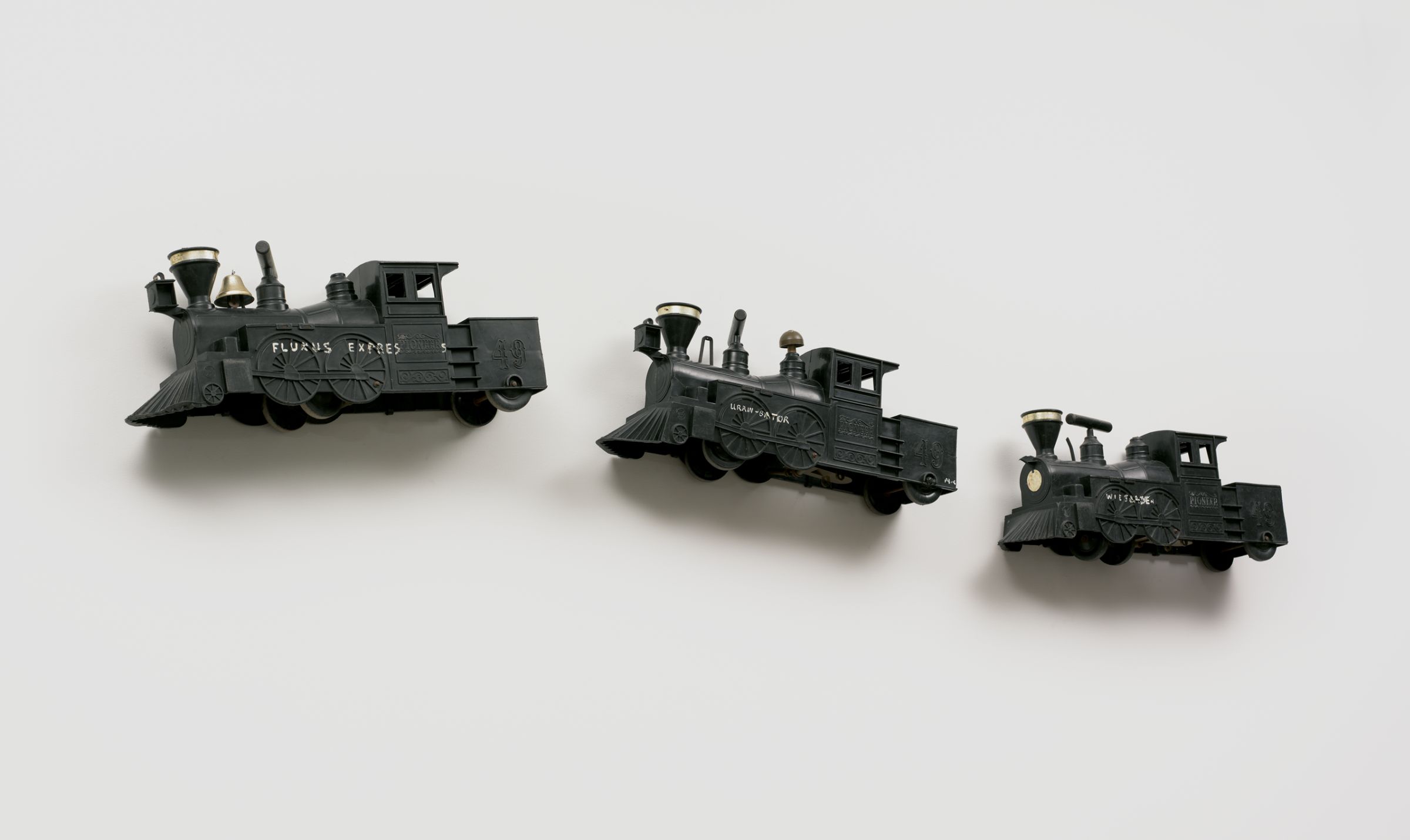Claes Oldenburg’s False Food Selection (1966) consists of a wooden box containing readymade plastic food items, such as a banana and a tomato. Made of isoprene rubber, the objects were originally rather realistic in appearance; today, they look deflated and somewhat unappetizing.
Here for the Long Haul
Their altered appearance, which was not the artist’s intent, provides a startling lesson that plastic isn’t nearly as stable an artistic material as wood, metal, or clay, for example.
“A lot of people think plastic is going to last forever, when, in fact, it may be one of the most fragile materials you can use,” said Georgina Rayner, an associate conservation scientist in the Straus Center for Conservation and Technical Studies. “Plastics degrade more quickly than probably anything in a museum collection, and by the time you start to notice the degradation, it’s almost too late. You can really only slow it down.”
The fate of False Food Selection and a number of other works made of plastic materials is what spurred Angela Chang, the Straus Center’s assistant director, to propose a comprehensive survey of plastics in the museums’ collections. Last year, Rayner and Elizabeth LaDuc, former objects conservation fellow, began carrying out the study. Assisted by Maille Radford, an undergraduate intern at the time, Rayner and LaDuc started the process of identifying and scientifically analyzing each work of plastic. It was no easy task, given that works of art haven’t always been labeled or categorized according to their plastic components.
“Mixed media,” for instance, could refer to a work made of any combination of plastic, paper, paint, fiber, found objects, or other materials. Even if a work has been broadly identified as containing plastic, the chemical formulation of specific types can vary tremendously; a work of polystyrene is very different from a work of cellulose acetate, and the two may need to be stored or treated in different ways. The signs of degradation among types of plastics can vary as well: with polyvinyl chloride, the surfaces may become sticky; with polyethylene, the surfaces may start to show cracks.
Assessing the Plastics
Rayner, LaDuc, and Radford first gathered works in the collections known to contain plastics, including objects labeled with Plexiglas, acrylic, rubber, and readymade. In the end, they found nearly 500 objects, which they then assessed to determine overall condition and relative need for conservation treatment. Next, they took samples from about 250 works—removing just tiny slivers of material—to use in analytical testing.
“A lot of people think plastic is going to last forever, when, in fact, it may be one of the most fragile materials you can use.”
Each sample was analyzed using the techniques of FTIR (Fourier transform infrared spectroscopy) and pyrolysis GCMS (pyrolysis-gas chromatography-mass spectrometry), which helped identify the type of material used in each, and provided key data that allowed Rayner, LaDuc, and Radford to distinguish between specific plastics. The information was immediately useful to the team as they adjusted how to treat each work.
In some cases, the test results revealed surprises. Rayner and LaDuc were particularly struck by the connection between Roni Horn’s White Dickinson CONFIDENCE IN DAYBREAK MODIFIES DUSK (2007) and Michael Joo’s seemingly very different Drawn (Japonensis) (2013). Horn’s sculpture, which is made in part of an aluminum bar, and Joo’s sculpture, which includes cast resin animal legs, contain the same polymer. The material, as it turns out, is not listed in a well-regarded reference book of synthetic polymers and is therefore yet to be identified.
“This project has been a real challenge, and that’s exciting for me,” said Rayner, who in her previous career developed polymers for the auto industry. For LaDuc, whose background is in archaeology, the project was an opportunity not only to explore a new area of conservation but also to consider future implications of the group’s work.
Catalyzing Change
LaDuc proposed two new projects as a result of the survey, one of which will support the digitization of works on plastic audiovisual materials, such as cassette tapes. The other involves changing the way that works made of rubber are stored—they will now be placed in an anoxic (oxygen-free) environment to prevent premature aging.
Rayner and LaDuc plan to share their findings across the museums’ departments, so that Collections Management staff, curators, and others will become better informed about plastics. In addition, the guidelines they developed will help staff make decisions about new acquisitions and will help them as they document the plastics contained in works of art.
“One great thing about this project is that it’s exposed us to so much more of our collections than we would normally have been able to see,” LaDuc said. Added Rayner: “It really connects to our institutional mission; we’re making the art more accessible to everyone, including future generations. I feel privileged to be able to work on this.”






